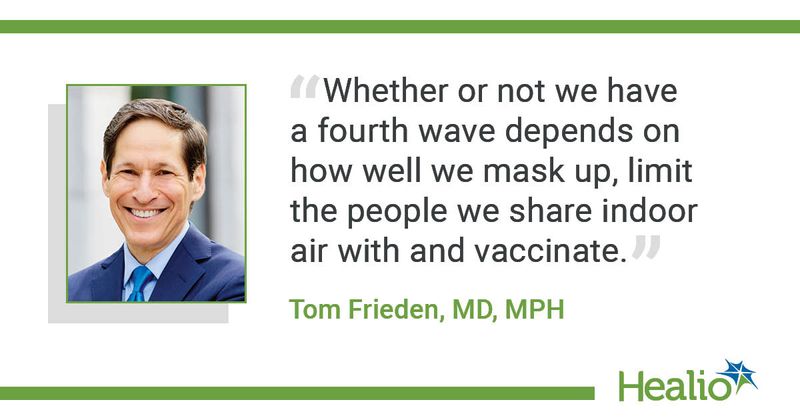Q&A: Will there be a fourth wave of COVID-19 in the US?
Following weeks of good news about diminishing case counts, CDC Director Rochelle P. Walensky, MD, MPH, said in a recent White House press briefing that the country had actually recorded an increase in COVID-19 cases for 3 straight days.
Walensky warned that declines in case counts and hospital admissions “may be stalling, potentially leveling off at still a very high number.”

“We at CDC consider this a very concerning shift in the trajectory,” she said.
We spoke with former CDC director Tom Frieden, MD, MPH, president and CEO of Resolve to Save Lives, about the trajectory of the pandemic and the possibility of a fourth wave in the United States.
Healio: Is it accurate to refer to it as a “fourth wave”?
Frieden: Yes, another surge in cases would be called a fourth wave because it would be the fourth time cases have spiked in the U.S. since March 2020. Nearly all of the U.S. is now experiencing a downward trend in cases. This is likely happening because we have passed the huge winter surge that took place while people were traveling for the holidays and meeting indoors. Many states are starting to lift restrictions because of this downward trend, but if the variants spread and people let their guard down, another spike in cases could arrive in the coming weeks — causing a fourth wave.
Healio: Will it happen?
Frieden: Whether or not we have a fourth wave depends on how well we mask up, limit the people we share indoor air with and vaccinate. If we do this correctly, there will be no fourth wave.
Healio: What major factors could determine if there will be another spike in cases?
Frieden: The first factor is how well we all collectively follow public health guidelines, including masking and physical distancing. This is especially important as businesses start to open and states relax other restrictions.
The second point is on vaccine distribution. The current supply is limited, but we need to make sure that everyone gets a vaccine when they qualify. This includes combatting vaccine hesitancy and ensuring that historically marginalized communities are reached.
The third factor will be ensuring that low- and middle-income countries have equitable access to the vaccines. Although other countries remain unvaccinated, there is a risk that new variants with the potential to evade current vaccines could arise and come to the U.S. The U.S. needs to step forward in partnership with the WHO, COVAX and other countries to ensure the world is vaccinated as soon as possible, including by scaling up manufacturing. Untampered spread anywhere is a risk to people everywhere.
Healio: When will we be able to “get back to normal” in the U.S.?
Frieden: If all goes as planned, most of the population will be vaccinated during this summer. In the fall, we should be able to resume activities such as going to movie theaters, restaurants, and concerts. However, COVID-19 will not magically vanish. There will still be certain guidelines in place to reduce risk of spreading the disease and of new variants. This includes wearing masks, cleaning contaminated surfaces such as door handles and elevator buttons more regularly and maintaining certain levels of physical distancing. This will have the added benefit of reducing spread of influenza and other infections.
This is an opportunity for society to build a healthier and more robust public health and primary care systems that will help prevent the spread of other diseases and reduce risk of the next pandemic.

